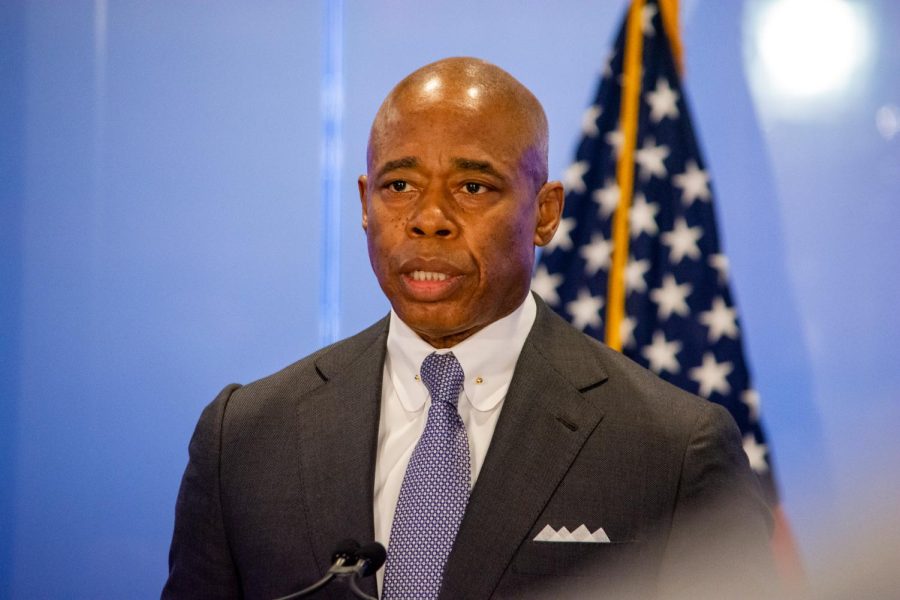Editorial: Eric Adams needs to house the homeless, not attack them
Mayor Adams wants to make our trains safer by removing unhoused individuals. His plan, unfortunately, relies heavily on policing and other forms of carceral violence.
On Feb. 18, Mayor Eric Adams announced a new subway safety plan that prioritizes the relocation of homeless individuals. (Staff Photo by Manasa Gudavalli)
February 28, 2022
Michelle Go was tragically pushed to her death at a subway station by an unhoused individual on Jan. 15. Her death incited much needed conversations about the rise in crime in New York City subways. This conversation is not just limited to Go’s death; in fact, New Yorkers have been feeling less and less safe on the subway since the beginning of the pandemic.
On Feb. 18, Mayor Eric Adams announced his subway safety plan in an effort to address the lack of safety that New Yorkers have been experiencing. The plan proposes 30 response teams that will be comprised of members of the Department of Health, the Department of Homeless Services, the New York City Police Department and community groups. The plan also involves training pre-existing NYPD transit officers to more vigilantly enforce Metropolitan Transportation Authority rules — which include preventing riders from lying down on the seats, littering, using drugs, or using the subway system for anything other than transportation.
Another important facet of Adams’ safety plan is the proposed addition of nearly 500 SafeHaven and Stabilization Beds — a transitional housing program that has few rules and regulations. Department of Social Services Commissioner Gary Jenkins said that the SafeHavens and stabilization spaces were “new beds,” but he did not provide specifics: How long people would be permitted to stay? How frequently were they allowed to utilize those beds?
“You can’t put a Band-Aid on a cancerous sore,” Adams said. describing how his plan would thoroughly address subway safety concerns and aid unhoused communities. “You must remove the cancer and start the healing process.”
His statement was rightfully criticized by the nonprofit Coalition for the Homeless advocacy group, who were disturbed upon hearing his comparison of unhoused individuals to cancer.
“They are human beings,” said Shelley Nortz, the group’s deputy executive director for policy.
Even more disheartening is Adams’ general lack of support for organizations that seek to provide unhoused New Yorkers with resources and support. Adams’ preliminary budget would cut funding for the DHS by $500 million. The city would also allocate less money to adult shelters beginning July 1.
Adrienne Adams, speaker of the New York City Council, said enforcement of MTA rules should not criminalize “people who are in need of housing or treatment.”
Unfortunately, Mayor Adams’ plan seems to do exactly that. It seems, as many homeless and mental health advocacy groups pointed out, that this plan does more to criminalize the unhoused and mentally ill than provide long-term, sustainable solutions that work to end cycles of homelessness.
While Adams insists that this plan isn’t about arresting people, he simply does not support the necessary infrastructure required to properly produce alternative outcomes. If this plan wasn’t about arresting, then why include the NYPD in the response groups at all? What will his response teams truly do when confronted with an unhoused person breaking the MTA’s rules? Many people who need shelter, medical attention for substance dependencies or serious mental health treatment will simply be sent to jail or detained in another punitive limbo rather than receive the help they need.
What we need to do is simply house the unhoused.
Eric Adams’ plan to fix homelessness relies much too heavily on detaining and punishing the homeless rather than helping them. In doing so, Adams doesn’t actually solve the safety problems many New Yorkers face on the subway, but instead perpetuates the unending cycle of homelessness. It has been shown time and time again that criminalizing homelessness is expensive and ineffective in addressing the issues many unhoused people face. Adams’ plan is yet another in a series of ill-planned efforts that ultimately amount to one thing: the expansion of the NYPD’s power over the city’s most vulnerable residents.
Opinions expressed in the house editorial reflect the views of the Editorial Board, which is composed of the Opinion Editors, the Deputy Opinion Editors and the Editor-in-Chief. The house editorial does not necessarily represent the opinions of WSN or its staff.
Contact the Editorial Board at [email protected].



























































































































































